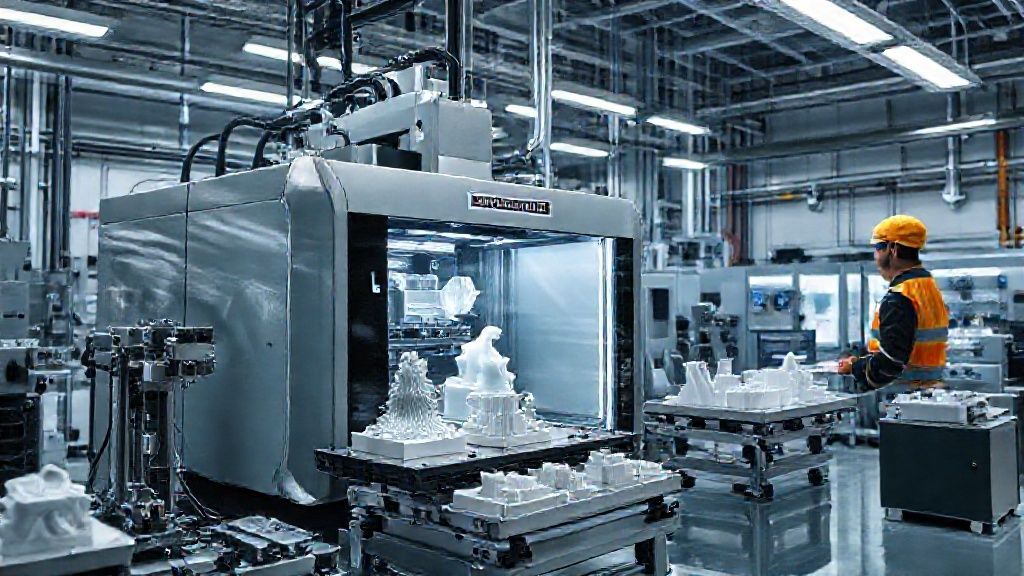RepMold: The Future of Fast and Accurate Mold Production
The manufacturing industry is undergoing a rapid transformation. Companies face unprecedented pressures to deliver products faster, reduce costs, and adopt sustainable practices. In this environment, traditional methods of production often struggle to keep pace, particularly in mold-making—a cornerstone of mass manufacturing. Enter RepMold, a transformative technology designed to redefine how molds are created, replicated, and utilized across industries. By combining precision, speed, and flexibility, it addresses the evolving demands of modern production.
Understanding RepMold
The term is derived from “Replication” and “Molding,” highlighting its core function: the rapid duplication of master molds. Unlike traditional mold-making, which is time-intensive, costly, and rigid, it enables manufacturers to produce high-quality molds quickly and efficiently.
Key Differences from Traditional Mold-Making:
- Faster Production Cycles: RepMold dramatically reduces the time required to produce molds, enabling companies to prototype and scale faster.
- Reduced Material Waste: The replication process minimizes unnecessary waste, contributing to cost savings and sustainability.
- Greater Flexibility: Design modifications can be implemented with ease, allowing manufacturers to adapt quickly to market demands or design changes.
By integrating it into production strategies, manufacturers gain a competitive advantage, combining agility, precision, and cost-effectiveness.
How it Works
It is not a single machine but a comprehensive methodology that leverages digital design, rapid prototyping, and advanced replication techniques.
1. Digital Design and Simulation
The process begins with Computer-Aided Design (CAD) models. Engineers use simulation software to predict how parts will behave under stress or thermal conditions, reducing errors before molds are physically created. This upfront digital validation is essential for high-precision applications.
2. Rapid Prototyping
Using 3D printing or CNC machining, prototype molds or master patterns are produced. These prototypes allow testing, validation, and iteration before committing to full-scale production. Rapid prototyping ensures designs are optimized and functional, saving both time and resources.
3. Replication Phase
Once the master mold is approved, RepMold allows for multiple production-ready molds to be created. This ensures high precision, uniformity, and repeatability, crucial for industries where even minor deviations can compromise safety or functionality.
4. Production Scaling
Replicated molds can be applied to plastics, metals, and composites, enabling a smooth transition from prototype to full production. This scalability supports short, medium, and sometimes larger production runs with consistent quality.
5. Continuous Optimization
It integrates feedback loops. Data from production molds—such as wear, defects, or material inconsistencies—can be analyzed to predict maintenance needs, refine designs, and enhance efficiency over time.
Core Benefits of RepMold
Speed and Efficiency
It shortens production timelines from months to days. This acceleration supports faster prototyping, testing, and product launches, keeping companies ahead of market trends.
High Precision and Consistency
Uniform molds reduce defects, ensuring every component meets strict specifications. Industries like aerospace and medical devices benefit greatly from this level of consistency.
Cost Savings
By minimizing material waste and reducing manual labor through automation, RepMold lowers overall production costs. It also reduces rework and errors, further improving profitability.
Flexibility and Adaptability
Unlike traditional molds, it allows quick adjustments, supporting diverse production runs and design changes without costly retooling.
Sustainability and Environmental Impact
It consumes fewer raw materials and is compatible with recycled or biodegradable materials. Streamlined processes reduce energy consumption, aligning manufacturing with modern environmental standards.
Applications of RepMold Across Industries
Automotive:
Rapid production of dashboards, engine components, and other precision parts accelerates prototype testing and product development.
Aerospace:
Lightweight, high-precision components meet stringent safety and performance standards while reducing material use.
Medical Devices:
Surgical instruments, implants, and casings benefit from consistent precision, ensuring patient safety and regulatory compliance.
Consumer Goods:
Intricate designs for gadgets, toys, and home products can be produced quickly, supporting customization and fast product launches.
Electronics:
Housings, connectors, and advanced device components are efficiently replicated with uniform quality.
Defense & Specialized Manufacturing:
Low-volume, high-precision parts are produced efficiently, supporting critical applications in defense and specialized industries.
Comparison with Other Manufacturing Methods
| Comparison | Traditional/Other Method | RepMold Advantage |
| Traditional Molds | Time-consuming and expensive | Faster turnaround, reduced waste, flexible adjustments |
| 3D Printing | Produces intricate shapes with high precision, but slower for replication | Ensures uniform, repeatable copies suitable for short-to-medium runs |
| CNC Machining | Produces intricate shapes with high precision but slower for replication | Speeds up duplication while maintaining acceptable precision |
| Hybrid Approaches | N/A | Combines 3D printing for master molds with it for replication, maximizing efficiency and accuracy |
Real-World Case Studies
Aerospace:
A mid-sized manufacturer faced delays due to mold defects. After implementing it, production delays decreased by 30%, defect rates dropped, and client trust improved.
Automotive:
Automakers accelerated prototype testing cycles, reducing iteration costs and speeding up product launches.
Medical Devices:
Manufacturers achieved regulatory compliance and high accuracy in surgical tools and implants, improving patient safety and reliability.
Consumer Goods:
Companies launched customized products faster while maintaining consistent quality, increasing market responsiveness, and customer satisfaction.
Challenges and Limitations of RepMold
While it is transforming manufacturing, it is not without its challenges. Understanding these limitations is crucial for companies looking to implement the technology effectively.
High Initial Investment
Setting up a system requires advanced machinery, 3D printers, CNC equipment, and specialized software for design and simulation. For small and medium-sized manufacturers, this upfront cost can be significant, necessitating careful budget planning and phased adoption strategies.
Skilled Technicians Required
It relies heavily on expertise for setup, calibration, and ongoing maintenance. Without skill operators, the advantages of high precision and consistency can be compromise. Training and retaining qualified personnel remain critical for successful implementation.
Mold Wear in High-Volume Production
Although it is highly effective for small to medium production runs, repeated use of molds can lead to wear, reducing their lifespan. Manufacturers must monitor mold condition and plan for replacements or maintenance to prevent defects in production.
Material and Design Constraints
While it supports a wide range of materials, highly complex designs or advanced composites may require hybrid approaches, combining traditional tooling with RepMold techniques. This can add complexity and planning requirements to production workflows.
Dependence on Raw Material Supply
Its efficiency can be disrupte if manufacturers face inconsistent access to quality resins, composites, or plastics. Reliable supply chains remain a prerequisite for maximizing the benefits of this technology.
RepMold and Industry 4.0
It is closely align with the principles of Industry 4.0, which emphasize automation, data integration, and smart manufacturing.
AI Integration for Predictive Maintenance
Artificial intelligence can analyze performance data from molds in real time, predicting wear and potential failures. This minimizes downtime, reduces waste, and ensures consistent production quality.
Smart Molds with IoT Sensors
Embedded sensors monitor temperature, pressure, and other key metrics throughout production. These insights allow for immediate adjustments and enhanced process control.
Data-Driven Automation
By collecting and analyzing operational data, manufacturers can automate quality checks, optimize production workflows, and enhance efficiency across the plant floor.
Digital Twins for Simulation
Digital twin technology creates virtual replicas of molds and production lines, enabling real-time testing and adjustments. This reduces trial-and-error and accelerates the implementation of process improvements.
Future Trends and Innovations
It is rapidly evolving in tandem with emerging technologies, promising to make manufacturing faster, more precise, and accessible across industries. AI-assisted mold design and monitoring will leverage machine learning to optimize production parameters and predict maintenance needs, enhancing efficiency and reducing downtime. Full automation, integrating robotics and automated systems, will allow hands-off production while maintaining high precision and consistency. Greater collaboration with 3D printing and additive manufacturing will enable faster, cost-effective creation of master molds, supporting rapid prototyping and small-batch production.
As a result, RepMold is poise for broader adoption in emerging sectors like renewable energy, advance packaging, and smart technology components, while even smaller manufacturers can scale production efficiently, fostering innovation and leveling the competitive playing field.
Conclusion
It is more than just a tool—it represents a strategic evolution in modern manufacturing. By combining speed, precision, flexibility, and sustainability, it addresses many of the challenges facing industries today.
From reducing production timelines and minimizing waste to ensuring consistent quality across sectors like aerospace, automotive, medical devices, and consumer goods, RepMold is proving indispensable.
As Industry 4.0, AI, and additive manufacturing continue to reshape production, it is poise to play a central role in smart, efficient, and environmentally responsible manufacturing.
For manufacturers seeking to stay competitive, integrating it into workflows is no longer optional—it’s essential. Those who invest early will likely enjoy faster processes, improved profitability, and a stronger foothold in the future of industrial innovation.






